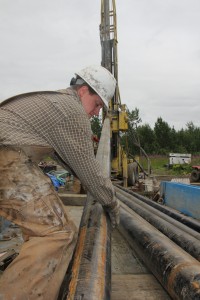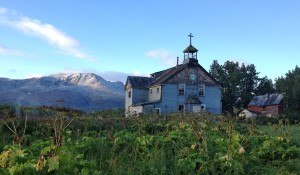Nome community, university collaborate on geothermal research
September 4, 2013

Julie Estey
907-355-4447
9/4/13
Nome, Alaska, could soon be known as the first community in the American Arctic to get its power from geothermal energy, thanks to a partnership among the University of Alaska Fairbanks, the City of Nome, and local native corporations and nonprofits.
After several years of research, a project team this week is drilling a large-diameter exploration hole in an effort to verify the size and extent of the geothermal resource at Pilgrim Hot Springs, which is 60 road miles from Nome. Once completed, a successful flow test would confirm the hot springs contain sufficient quantity of hot water to support construction of an on-site power production facility and transmission lines to Nome.
Research in 2011 and 2012 by the UAF Alaska Center for Energy and Power and the UAF Geophysical Institute indicated that the hot springs was likely to have adequate water temperatures to generate power. Projections show that Pilgrim Hot Springs has the potential to generate at least two megawatts of electricity, which is sufficient to satisfy a sizable portion of Nome’s needs.

The exploration project at Pilgrim Hot Springs is a result of a public-private collaboration. Beginning in 2010, with funding from the Alaska Energy Authority and the federal Department of Energy, ACEP partnered with Unataaq, LLC, a consortium of seven regional Native corporations and nonprofit organizations, to test an exploration technique developed by the UAF Geophysical Institute. The project gained momentum when ACEP’s initial findings attracted the interest of a private developer, Potelco, Inc. Today, ACEP is working with Unaatuq, the City of Nome, Nome Joint Utility Services, and Potelco, Inc., with the goal of delivering geothermal energy to Nome by the end of 2014. In addition to exporting power from the site, the geothermal resource offers substantial opportunities for on-site development, such as bathing and tourism, greenhouses and fish hatcheries. The site is on the National Register of Historic Places and has long held special significance for residents of Nome and the greater Seward Peninsula, both as a recreational destination and because of the historical, subsistence and cultural significance of the site.
“The Pilgrim Hot Springs project represents the benefits that can follow when university researchers partner with communities and developers,” said Gwen Holdmann, ACEP director. “Our goal is to make a real difference in meeting the energy needs of Alaskans.”
Over the past month, local partners and others have not only brought their expertise and enthusiasm to the project, but have also made investments of their own. The City of Nome, Nome Chamber of Commerce, Bering Straits Native Corporation, Mary’s Igloo Native Corporation, White Mountain Native Corporation, Sitnasuak Native Corporation, Potelco, and others have contributed a total of $600,000 in philanthropic and in-kind contributions to support the work.
That support, along with additional funding from the U.S. Department of Energy, is enabling progress toward the project’s milestone this week.
“Cooperative partnerships between the public and private sector can solve problems. The Pilgrim project is a great example,” said Nome Mayor Denise Michels. “It gives renewed hope for tackling the energy availability and affordability issues that burden families and businesses not just in Nome, but across rural Alaska.”
ADDITIONAL CONTACTS: Gwen Holdmann, ACEP director, at 907-590-4577 or gwen.holdmann@alaska.edu.
JE/9-4-13/047-14


